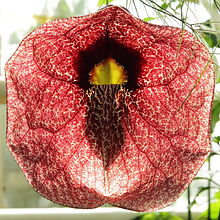|
Aristolochia gigantea
Aristolochia giganteaAristolochia gigantea, the Brazilian Dutchman's pipe or giant pelican flower (syn. Aristolochia sylvicola Standl.), is an ornamental plant native to Brazil, Costa Rica and Panama.[1] Typical of subtropical Bahia and Minas Gerais vegetation. This plant is cited in Flora Brasiliensis by Carl Friedrich Philipp von Martius. A. gigantea and other tropical Dutchman's pipe varieties pose a threat to the pipevine swallowtail butterfly. The butterfly confuses A. gigantea with its native host plant and will lay eggs on it although pipevine swallowtail caterpillars cannot survive on the foliage[2] because the leaves are toxic to the larvae.[1] CultivationIn cultivation in the UK - where it must be grown under glass - this plant has gained the Royal Horticultural Society's Award of Garden Merit.[3] It does not tolerate temperatures below 10 °C (50 °F). It can be grown from seeds or cuttings. MorphologyIt is a vigorous woody evergreen climber (vine). Leaves are simple with a cordate heart shape and a petiole. Inflorescence has a single zygomorphic (bilateral) flower that is bisexual. Contains 6 stamens that are fused to form a gynostemium. There is a syncarpous gynoecium present[4]. References
External linksWikimedia Commons has media related to Aristolochia gigantea.
|
||||||||||||||||||||||||||


